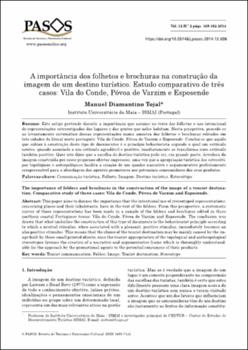A importância dos folhetos e brochuras na construção da imagem de um destino turístico. Estudo comparativo de três casos: Vila do Conde, Póvoa de Varzim e Esposende
Author
Tojal, Manuel DiamantinoDate
2014Abstract
Este artigo pretende discutir a importância que assume no texto dos folhetos o uso intencional
de representações estereotipadas dos lugares e das gentes que neles habitam. Nesta perspetiva, procede -se
ao levantamento sistemático dessas representações numa amostra dos folhetos e brochuras editados em
três cidades do litoral norte português: Vila do Conde, Póvoa de Varzim e Esposende. Conclui -se que aquilo
que subjaz à construção deste tipo de documentos é o princípio behaviorista segundo o qual um estímulo
neutro, quando associado a um estímulo agradável e positivo, imediatamente se transforma num estímulo
também positivo. Quer isto dizer que a escolha do destino turístico pode ser, em grande parte, devedora da
imagem construída por esses pequenos objetos impressos, uma vez que a apropriação turística dos estereóti-
pos topológicos e antropológicos facilita a criação de um quadro narrativo e argumentativo perfeitamente
compreensível para a abordagem dos agentes promotores aos potenciais consumidores dos seus produtos. This paper aims to discuss the importance that the intentional use of stereotyped representations,
concerning places and their inhabitants, have in the text of the folders. From this perspective, a ystematic
survey of those representations has been made in a sample of the folders and brochures edited in three
northern coastal Portuguese towns: Vila do Conde, Póvoa de Varzim and Esposende. The conclusion was drawn that what underlies the construction of this type of documents is the behaviourist principle according to which a neutral stimulus, when associated with a pleasant, positive stimulus, immediately becomes an also positive stimulus. This means that the choice of the tourist destination may be mainly caused by the im-
age built by those small printed objects, once the tourist appropriation of the topological and anthropological stereotypes favours the creation of a narrative and argumentative frame which is thoroughly understandable for the approach by the promotional agents to the potential consumers of their products.





